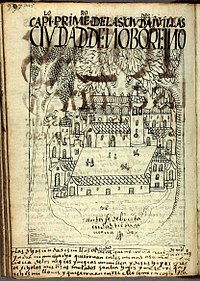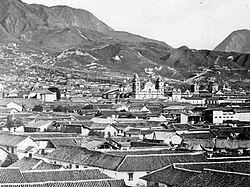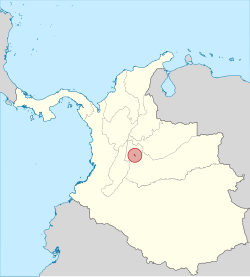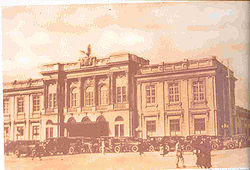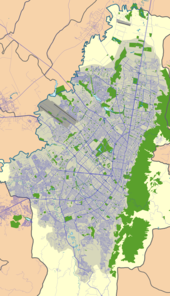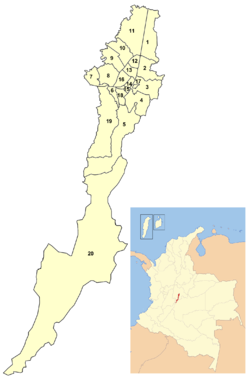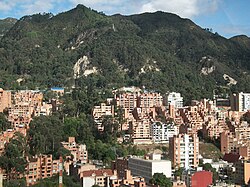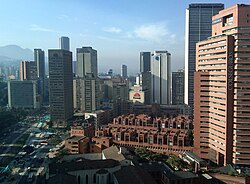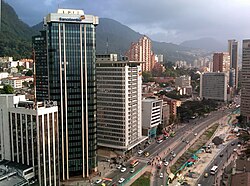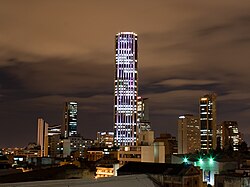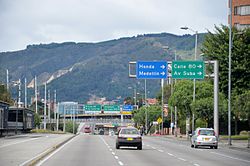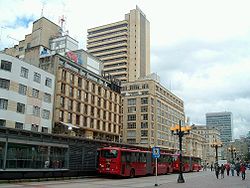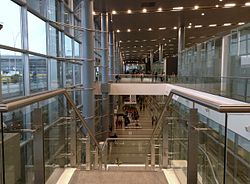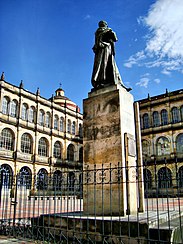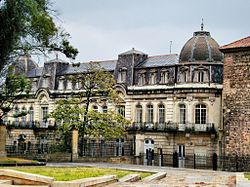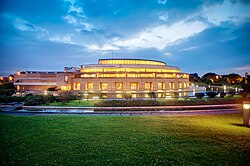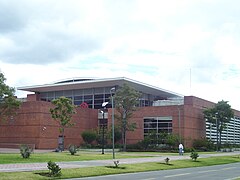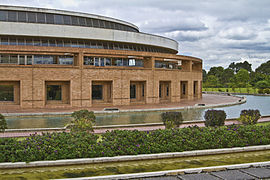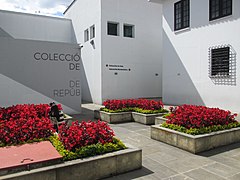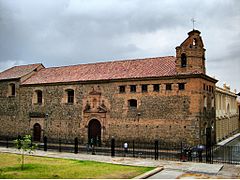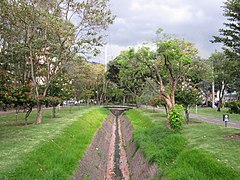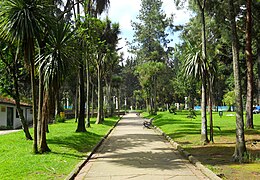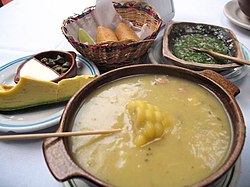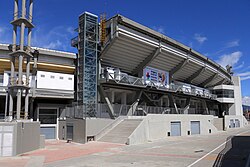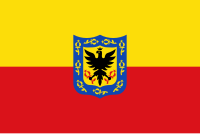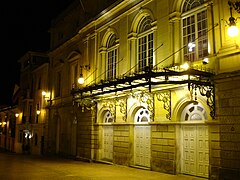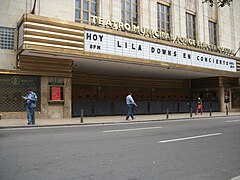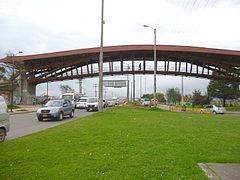Bogota
Bogotá, officially Bogotá, Capital District (formerly Santafé de Bogotá and originally Santafé), is the capital of the Republic of Colombia and the department of Cundinamarca. It is administered as a capital district, and enjoys autonomy for the management of its interests within the limits of the Constitution and the law. Unlike the other districts of Colombia, Bogotá is a territorial entity of the first order, with the powers that the law confers on the departments. It is made up of 20 localities or districts, where each of these has its own mayor, who is called the Minor Mayor, and a Local Administrative Board (JAL), and is the epicenter political, economic, administrative, industrial, artistic, cultural, sports and tourism of the country.
Bogotá was founded as the capital of the New Kingdom of Granada on August 6, 1538 by the Spanish conquistador Gonzalo Jiménez de Quesada after a tough expedition into the Andes.
It is the third highest capital in the world (after La Paz and Quito), since it is located at an average of 2625 meters above sea level. It is located in the center of Colombia, in the natural region known as the Bogotá savannah, which is part of the Cundiboyacense plateau, a formation located in the Eastern Andes mountain range.
It is 33 km long from south to north, and 16 km from east to west. As the capital, it houses the highest-ranking bodies of the executive (Presidency of the Republic), legislative (Colombian Congress) and judicial (Supreme Court of Justice, Constitutional Court, Council of State and the Superior Council of the Judiciary).
According to The Economist, on an economic level, Bogotá stands out for its economic strength associated with the size of its production, the facilities for creating companies and doing business, financial maturity, attracting companies and the quality of its human capital. It is the main market in Colombia and the Andean Region, and the first destination of foreign direct investment that arrives in Colombia (70%). It has the highest nominal GDP and per capita of the country, contributing most of the national total (24.5%), and it is the sixth city by size of GDP in Latin America (about 106,678 million dollars) with a GDP per nominal capita of 11,594 dollars and a GDP PPP per capita of 20,120 dollars, it is also the largest business platform in Colombia where most of the high-impact ventures occur.
The city's airport, El Dorado International Airport, named after the mythical El Dorado, has the largest volume of cargo transported in Latin America, and is the second in number of people. It is the city in Colombia with the largest number of universities (114) and research centers. It has a wide cultural offer represented in a large number of museums, theaters and libraries, which has given it the recognition of the "Athens of South America". ». The city of Bogotá ranks 55th in the Global Cities Index 2018, and is considered a "Beta +" by the GaWC.
The World Economic Forum (WEF) International Organization based in Geneva (Switzerland) highlighted Bogota among the five cities in the world, for promoting, in the midst of the COVID-19 pandemic, the use of bicycles. Although it already had 550 km of cycling infrastructure, in mid-March 2020 a further 117 km were temporarily added.
Etymology
The name of Bogotá derives from the word of the Muisca language "Bacatá", name of the capital of the Zipa confederation in the ancient Muisca civilization, which has several meanings, standing out the one that says it means "the lady of the Andes". And Andes in the Aymara language means "the mountain that lights up" or "the mountain that shines". Thus, Bogotá would become "the lady of the mountain that shines". Another known meaning would be "fenced outside the farm". The Spanish chronicler Juan de Castellanos stated that the original voice of bacatá translates "the end of the fields".
The area to the west of where the city currently stands was called Muequetá ("field or savannah of farming") and the population of the zipa (the most important Muisca prince) was Funza ("powerful male"). Precisely in the territory of the current municipality of Funza, a suburb of Bogotá, and probably in its village El Cacique, was the head of the population of Bacatá, the most important city of the Muisca people, but the Muisca Prince received education in the current Municipality of Chía.
Throughout history, Bogotá and its surroundings have been known by different names. The original name, in the Muisca language, of the place where the Spanish would found the city was Thybzacá or Teusacá, from which Teusaquillo was derived.
In 1538, when the conquistador Gonzalo Jiménez de Quesada founded the city, in the current historic center, he gave it the name of Nuestra Señora de la Esperanza. However, two years later, on July 27, 1540, during the legal foundation and through the petition for the title of city, the name is changed to Santafé or Santa Fe.
The name "Santafé de Bogotá" (or "Santa Fe de Bogotá") was not official during the viceregal era, but its use became common due to the need to distinguish this Santafé from other cities with the same name, being Bogotá the indigenous name of the region. During this time the current population of Funza was called Bogota.
After the independence of 1819, Santa Fe received again the indigenous name of the old Muisca capital: Bogotá (name that at the time, the current population of Funza had and due to this it was renamed in such a way). However, Santafé de Bogotá was commonly referred to only as Santa Fe, to distinguish it from the current Funza.
The 1991 Constitution changed the name of the capital to Santa Fe de Bogotá. The controversy unleashed by this change forced the approval of a constitutional reform on August 18, 2000 to suppress the words "Santa Fe de", leaving the city again with the name of Bogotá, through legislative act 1 of the Congress of the Republic.
History
Pre-Hispanic period
In areas surrounding Bogotá, such as Pubenza, Tocaima, remains of tools have been found whose radiocarbon dating places them at least 16,000 years ago, just during the ice age. During the late glacial (approximately 12 500 years ago), when the ice retreat began, the climate improved and the Andean forest invaded the Bogotá Sabana. The surroundings of the current city began to be covered with sub-páramo vegetation. There is evidence of the presence and abundance of game animals in the area, such as rabbits, deer, and perhaps mastodons and horses at that time. This encouraged the incursion of hunting groups in the area. It is estimated that the semi-permanent habitation of the highlands began at this time, by inhabitants of the Magdalena Valley. In the archaeological site of El Abra it has been possible to verify the human presence for at least 11,000 years.
The first evidence of horticultural activities has been found in Aguazuque: calcined remains of ibia and squash dated to 3860 years, a time when a long period of dry weather began and conditions were recorded that gradually generated horticultural practices. to favor the consumption of the curí over the deer of antlers that begin to be scarce. Later, the curí was domesticated by the inhabitants of the place. Around 1000 BC. C. there was a change in social practices, evidenced by the presence of ceramics, agricultural activities and the construction of raised fields for cultivation.
The characteristics of the ceramics have characterized the Herrera Culture, evidenced by various archaeological sites dating from 400 BC. C. and at least until 800 or 1000 of the current era, a period in which the cultivation of corn, beans and potatoes was already widespread. Around the year 800, the Muiscas (the most important indigenous people of the Chibcha family) inhabited the area, as a result of a migration of Chibcha origin, coming from another territory (probably from Central America), and who mixed with the previous population.
The Muisca culture lacked writing, therefore, the chroniclers reconstructed the aboriginal history collecting the facts through oral accounts that date back to the year 1470, when the Zipa Saguanmachica governed Muequetá (currently Funza). On the summit of The scale of the Muisca social organization was the Zipa, whose domain was exercised from Chocontá and Ubaté to Tibacuy and had integrated the chiefdoms of Guatavita and Sumapaz (sutagaos). Subordinate in the hierarchy to the Zipa and the psihipqua or caciques ("princes"), were the zibyntyba, called by the Spanish "captains" 3. 4; of the zibyn or sibyn and to these the utatyba ("minor captaincies"), leaders of the uta communities . The zibyn were matrilineages and the descendants of the chiefs corresponded to their sister's son, so that the successor of the Zipa was his nephew, the cacique of Chía. Various strata fulfilled the religious functions of chyquy ("sheikhs") and supquaguyn ("mohanes").
It is believed that, prior to the construction of temples, the Muiscas were able to practice human sacrifices of young virgins or those captured in war or bought from other tribes. However, there is no solid or verifiable evidence of this. They also created a highly precise calendar and a complex legal structure, known as the "Nemequene Code". On the other hand, the Muisca buildings were built with perishable materials that prevented them from standing after the arrival of the conquerors. Europeans.
Viceregal period
After arriving with fewer than 200 men on his expedition from Santa Marta and ending up with just 70 after defeating the Muiscas and conquering the Sabana de Bogotá, the Spaniard Gonzalo Jiménez de Quesada officiated the "foundation of fact" from the city. The ceremony took place on August 6, 1538, with the construction of twelve bohíos and a chapel on the site called Thybzaca (today Teusaquillo). It is presumed that the event occurred in the current Plazoleta del Chorro de Quevedo, although there are no documents. to confirm it. On April 22, 1539, Jiménez de Quesada also made the "legal foundation" de Santafé in the company of Nicolás Federmann and Sebastián de Belalcázar. Initially called Nuestra Señora de la Esperanza, in the legal foundation it changed its name to Santafé.
The royal decree of Emperor Carlos I elevated Santafé to the category of city on July 27, 1540. The Cabildo de Santafé had already been established in 1539, and in 1548 the emperor granted it the title of very noble, very loyal and the oldest city of the New Kingdom, and as a coat of arms a shield on which is a black eagle on a field of gold, with an open pomegranate in each claw, bordered by some branches of gold on blue field.
Since Jiménez de Quesada named, in 1538, all the territories surrounding Santafé as the New Kingdom of Granada, Santafé was throughout the viceroyalty period the seat of government of the Audiencia del Nuevo Reino de Granada (created in 1550) and its capital, dependent on the Viceroyalty of Peru.
Starting in 1717, the city was the capital of the Viceroyalty of Nueva Granada, hosting the viceroys, after having disputed the viceroyal seat of Cartagena de Indias. In 1783, Viceroy Antonio Caballero y Góngora created a scientific commission, directed by José Celestino Mutis, who began his research in the hills of Santafé, the first steps of what would later be known as the Botanical Expedition. Alexander von Humboldt visited Bogotá at the beginning of the century XIX, attracted by its cultural and scientific institutions, among which was the first astronomical observatory in America, and which had been promoted by Mutis.
Some of the most influential Creoles of the Viceroyalty lived in the city (heroes such as Policarpa Salavarrieta and Antonio Nariño), so it was largely there where the independence movement was gestated in which the events that They are known as the event of "El Florero de Llorente", when the brothers Francisco and Antonio Morales entered to borrow, to decorate a dinner with a royal official arrived from Spain, a vase from the Spanish merchant José González Llorente, who had a store in the northeast corner of what is now called Plaza de Bolívar, being rejected in a bad way by it, which was taken as an excuse to provoke a brawl that ended in riots among the population. This event marks the beginning of the struggles and the Cry for Independence. Although the territory was reconquered by the Spanish in 1816, final independence was finally obtained in 1819 after the patriot victory in the Battle of Boyacá.[citation required]
Republican period
The city became the capital of Greater Colombia until 1830, when this state dissolved giving rise to the current states of Ecuador, Venezuela and Colombia (Panama would separate in 1903). The history of Colombia in the rest of that century was a string of civil wars. The most transcendental was the Thousand Days War, in which the Conservative and Liberal factions bled the country dry between the end of the XIX century and early xx.
The Federal District of Bogotá was created on June 23, 1861 so that the city would be the residence of the federal government of the then United States of Colombia. At that time the limits of the district were the Arzobispo and San Francisco rivers (to the north), Fucha (to the south), Bogotá (to the west) and the eastern hills (to the east). However, it was suppressed in 1864 and its territory returned to the then Sovereign State of Cundinamarca.
In 1876 the City Council established the nomenclature and numbering of streets and roads, changing the traditional street names to consecutive numbers as they are used today. During the existence of the United States of Colombia (1863-1886), Bogotá received the title of Federal Capital and its few neighborhoods were elevated to the category of cantons. In 1889 the first line of the Bogotá Railroad from San Victorino to Facatativá was opened, which, at the end of the XIX century, It already had more than 100 km of railways allowing, with the junctions, to reach different areas of the country and even to the Caribbean Sea. In 1884 the mule tram service began to operate (from the Plaza de Bolívar to Chapinero), and in 1910 the electric tram system did the same, which until the 1940s extended on multiple lines around the city and its surroundings.. Together with the train, these means of transport were the pillars of the development of this city, which in 1912 had a population of just over 120,000 inhabitants.
In 1905 the territorial division of Colombia was completely reorganized and by means of law number 17 of April 11, the district was created again with the name of Capital District of Bogotá. This division was repealed in 1910 and the district ceased to exist that same year, Bogotá once again becoming a municipality of Cundinamarca.
In the 1920s, the first airport in Latin America was inaugurated in Bogotá and the supply of uninterrupted electricity to the city began, with the construction of a power station in the Salto del Tequendama that is still in operation. Starting in the following decade, the first urban projects were carried out on the occasion of the fourth centenary of the founding of the city: an urban complex in the Teusaquillo neighborhood, the Ciudad Universitaria, the National Park and the Nemesio Camacho El Campín stadium. However, this flowering was stopped after the death of Jorge Eliécer Gaitán on April 9, 1948, which was followed by the destruction and looting of part of the city, in the event known as the Bogotazo. One of the consequences was that the wealthy families, who until then had mostly inhabited the center of the city, gradually moved to other sectors of the city such as Chapinero and El Chicó, and even to nearby towns such as Usaquén and Suba.
During the IX Pan-American Conference held in the city in 1948, the Pact of Bogotá was signed, which led to the creation of the Organization of American States (OAS). The military dictatorship of the mid-1950s In the 1950s, directed by General Gustavo Rojas Pinilla, it contributed to the development of the city, thanks to the construction of the North Highway, the new El Dorado International Airport and the reconstruction of the avenue that linked it to the city center (Calle 26) and the International Center, near where the Hotel Tequendama had been inaugurated years before. In 1961, the construction of the Ciudad Kennedy neighborhood was developed as part of the Alliance for Progress, led by the United States government.
In 1954, through Legislative Decree 3640, the Special District of Bogotá was created signed by President Gustavo Rojas Pinilla, which came into force on January 1, 1955. Through Ordinance Number 7 of the Administrative Council of The neighboring Cundinamarca municipalities of Bosa, Engativá, Fontibón, Suba, Usme and Usaquén were annexed to Cundinamarca, as well as part of the Sumapaz Agricultural Colony., being Chapinero the one that was constituted as the first minor mayor of the city, followed in 1964 by Puente Aranda and 1967 by Ciudad Kennedy. Five years later, the district was divided into 16 minor municipalities, including the annexed municipalities. The new mayoralties were Santa Fe, Teusaquillo and Los Mártires, Barrios Unidos del Norte, Antonio Nariño, San Cristóbal and Tunjuelito, segregated from Usme. In 1977 the minor mayor's office of La Candelaria was created, and in 1983, due to the chaos generated by the invasions to the south, the government ordered the Ciudad Bolívar plan and this became another town in the city.
The city in the framework of the internal armed conflict in Colombia since 1960, has experienced events such as: the seizure of the embassy of the Dominican Republic, the assault on the North Canton, the massacre of the Southeast, the seizure of the Palace of Justice, the attacks on the DAS building and in the city perpetrated by drug traffickers, the terrorist attack against Club El Nogal, the attack on the Police School, kidnappings, murders as well as acts of peace and memory.
With the Constitution of 1991, the Special District became a Capital District, the zones were elevated to localities, dividing the District into 20 localities, now including that of Rafael Uribe Uribe segregated from Antonio Nariño. Finally, and with extensive rural density, the town of Sumapaz was annexed, until then the largest in Bogotá, which houses immense layers of forest from its border with Usme to the páramos of the Guapé River.
From the first term of Antanas Mockus as mayor, in 1994, the capital underwent important changes. The TransMilenio transport system was developed, the pedestrian space was recovered, the construction of a network of libraries was carried out public and various sections of bike paths. In addition to that, measures such as Pico y placa, Carrot Hour and social programs were implemented, such as community kitchens and the expansion of educational coverage for the low-income population.
Political-administrative organization
Organic Status of Bogota
With the elevation of Bogotá to a first order entity, it was given its absolute political, fiscal and administrative separation from the department of Cundinamarca. For this reason, since the creation of the Special District of Bogotá in 1954 (that is, when the seven neighboring municipalities were annexed), the now Capital District became an entity outside the territorial jurisdiction of the department of Cundinamarca, but maintaining itself as the headquarters and therefore capital of the territorial body. This situation has led to considering the possibility of establishing another capital for the department.
Metropolitan Region
Legislative act 02 of July 22, 2020, of the Congress of the Republic of Colombia, created the Bogotá-Cundinamarca Metropolitan Region administrative entity of regional associativity of special regime, which will have a Regional Council (formed by the mayor of Bogotá, D.C., the municipal mayors and the governor of Cundinamarca) who will make decisions on the problems of Bogotá and the municipalities of Cundinamarca that are associated with the Metropolitan Region on issues such as transportation, however, the entities that make it up will maintain their autonomy.
Municipal hearings are being held virtually, in the territories that intend to be incorporated into the Metropolitan Region, on August 27 the first hearing was held in Funza, on September 1 in Madrid, on September 3 September in Mosquera, on September 8 in Chía, on September 10 in Cajicá, on September 15 in Sopo, on September 17 in Cota, on September 22 in La Calera, on September 24 in Facatativá, on September 1 October 1st in Zipaquirá, October 8th in Soacha and October 15th in Fusagasugá.
Administration
Bogotá is contemplated within the Colombian Political Constitution as the only capital district that together with the 32 departments, make up a total of 33 different and independent administrative units. Bogotá is made up of an urban area and a rural area.
The Council of Bogotá is in charge of exercising political control over the executive, its administrative acts are called “agreements”. It is made up of 45 representative councilors from the twenty localities, who are democratically elected every four years; In the same way, it has district secretariats (health, mobility, education, among others) and a department that manages environmental issues (Departamento Técnico Administrativo del Medio Ambiente - DAMA) which in 2006 became the Secretary of the Environment. The judiciary in the city is made up of different judges and magistrates. Because it is the capital of the country, you can find all the jurisdictional hierarchies, as they are at the national level: the Supreme Court of Justice, the Council of State, the Constitutional Court and the Superior Council of the Judiciary; At the district level, the Superior Court of Bogotá with its different Decision Chambers, which is made up of 9 members and divided into four chambers, which each meet with three Magistrates as follows: Civil, Agrarian and Family Decision Chamber, Labor decision room, Criminal decision room and Administrative decision room. Finally, at the basic level there are the Circuit and Municipal Courts in their different specialties (Civil, Criminal, Labor, etc.). In addition, the Superior Court of Bogotá acts as a guarantee control court for those processes that are followed by high state officials (for example, generals) before the Supreme Court of Justice in sole instance.
Mayor
The mayor of Bogotá is the head of government and local administration, legally, judicially and extrajudicially representing the city. Due to the number of voters that his constituency has, he is considered the second most important popularly elected position in the country, after the President of the Republic. The position is democratically elected for a period of four years. In addition, each of the subdivisions that Bogotá has, called localities, has a local Mayor, appointed by the Mayor, by short list sent by the Local Administrative Board, and under the supervision of this, who are in charge of coordinating the administrative action of the district government. in each locality.
The current mayor is Claudia Nayibe López Hernández, elected by popular vote on October 27, 2019. Her term began on January 1, 2020 and will end on December 31, 2023.
Council
The District Council is the highest authority in political-administrative matters, it is in charge of exercising political control over the administration of Bogotá and issuing regulations to promote the integral development of the city and its inhabitants, in compliance with the essential purposes of the Social rule of law. It is currently made up of 45 councilors who are democratically elected for a period of four years.
Administrative division
Bogotá is divided into 20 localities and in these are grouped more than 1900 neighborhoods that exist in the urban area, except for the locality of Sumapaz, which is a rural area.
Each town has a Local Administrative Board -JAL-, made up of no less than seven and no more than eleven members, elected by popular vote for a period of four years that must coincide with the period of the Bogotá Council.
A JAL fulfills functions concerning the district plans and programs for economic and social development of public works, surveillance and control of the provision of public services in its locality and the investments made with the resources of the Capital District, in addition concerning the distribution of global items assigned by the district budget and, in general, ensure compliance with their decisions, recommend the adoption of certain measures by the authorities of the Capital District, and promote citizen participation.
The locations are:
| N.o | Locality | Postal codes | Area km2 | Population | Density hab./km2 |
|---|---|---|---|---|---|
| 01 | Use them | 110111-110151 | 65.54 | 501 999 | 7 686.4 |
| 02 | Chapinero | 110211-110231 | 35.78 | 139 701 | 3 661.88 |
| 03 | Santa Fe | 110311-110321 | 44.82 | 110 048 | 2 436.3 |
| 04 | San Cristobal | 110411-110441 | 48.83 | 404 697 | 8 243.98 |
| 05 | Usme | 110511-110571 | 122.63 | 457 302 | 2 126.39 |
| 06 | Tunjulito | 110611-110621 | 10.79 | 199 430 | 20 124.11 |
| 07 | Bosa | 110711-110741 | 24.22 | 673 077 | 28 126.91 |
| 08 | Kennedy | 110811-110881 | 38.72 | 1 088 443 | 28 205.31 |
| 09 | Fontibón | 110911-110931 | 33.32 | 394 648 | 11 858.41 |
| 10 | Engativá | 111011-111071 | 36.06 | 887 080 | 24 723.52 |
| 11 | Suba | 111111-111176 | 101.07 | 1 218 513 | 12 117.27 |
| 12 | Barrios Unidos | 111211-111221 | 11.92 | 243 465 | 20 459.24 |
| 13 | Teusaquillo | 111311-111321 | 14.2 | 153 025 | 10 784 |
| 14 | The Martyrs | 111411 | 6.53 | 99 119 | 15 225.65 |
| 15 | Antonio Nariño | 111511 | 4.99 | 109 176 | 22 372.12 |
| 16 | Puente Aranda | 111611-111631 | 17.24 | 258 287 | 14 921.25 |
| 17 | La Candelaria | 111711 | 1.83 | 24 088 | 11 693.2 |
| 18 | Rafael Uribe Uribe | 111811-111841 | 13.44 | 374 246 | 27 060.44 |
| 19 | Ciudad Bolívar | 111911-111981 | 130 | 707 569 | 5 442.83 |
| 20 | Sumapaz | 112011-112041 | 780.96 | 6 531 | 8.36 |
The localities are subdivided in turn into Local Planning Units (UPL), and these group several neighborhoods and, in the rural part, villages.
Urban layout and nomenclature
The layout of the roads in Bogotá uses the Cartesian coordinate system, with north to the left of the maps. The urban layout is based on a focal point in a central square, typical of Spanish settlements; but the design gradually becomes more modern in the suburbs.
Types of roads
| Streets | Careers | Transversal | Diagonal |
|---|---|---|---|
| Via perpendicular to the axis of the eastern hills; the numbering is increased from street 1 (first) to north or south, in which case “South” is added. Suffixes can be added to differentiate pathways with the same main number. The abbreviation is "CL". | The path parallels the axis of the eastern hills; the numbering is increased from race 1 (first) to the west or to the east, in which case “East” is added. Suffixes can be added to differentiate pathways with the same main number. The abbreviation is "CR" or "KR". | The oblique way about the races, close to its axis and has the same nomenclature of these. The abbreviation is "TV".
It is common in urbanized areas after 1930. | The oblique path to the streets, close to its axis and has the same nomenclature of these. The abbreviation is "DG".
It is common in urbanized areas after 1930. |
Address plates
They are identified with a dark green plate with white letters and the city's coat of arms printed on it. They are located at the top of the main door of the property.
The generating road is the one that gives the location to the property on the main road: For the properties located in streets and diagonals, those located in the western sector will have as number the road that is located in the eastern corner of the block, those located in the eastern sector will have the number of the road that is located in the western corner of the block. For the properties located in carreras and transversals, those located in the north sector will have the number of the road that is located in the south corner of the block, those located in the south sector will have the number of the road that is located in the north corner of the block.
The property number corresponds to the approximate distance in meters from the gate to the corner of the generating road, in the streets and diagonals, the odd numbers are on the south side and the even numbers are on the north, and on the streets and transversal, the odd ones are on the west side and the even ones on the east.
Those located in the corners indicate in large letters the main route where the plate is located, and in smaller letters, in the lower part of the plate, the generating route. In the case of avenues and highways, the common name appears at the top of the plate. Here are some examples:
- Palacio Liévano, headquarters of the Mayor's Office, has the address Kr. 8 #10-65, which means that the main door is in race 8, on the western side, about 65 m from the corner of street 10.
- Kennedy's local mayor, has the address Tv 78K #41A-04 South, which means that the front door is in the 78K crossroads on the eastern side, about 4 m from the corner of 41 A South.
Irregularities
Some main roads have their own name and even several names in different sectors. For example, Avenida Jiménez, in the historic center, bears that name to the east of Carrera 14 (Avenida Caracas), but to the west it is called Avenida Centenario.
In the first block south of Calle 1 and east of Carrera 1, the license plates have the number 0 followed by the number of the approximate distance from the corner of Calle or Carrera 1. Despite this, the street "0" it is nonexistent.
Layering
Each area of the city is classified depending on the characteristics of the dwellings, the urban environment of the area and the urban context. This is how the city is subdivided into 6 socio-economic strata, 1 being the lowest and 6 the highest. This in order to identify areas of action and distribute the cost of public services; where the highest strata subsidize the lowest and these in turn can access educational or health benefits given the stratification. This has allowed the city to quickly identify vulnerable sectors and this is how, among other things, it has managed to guarantee free minimum water consumption to strata 1 and 2 (the first and only city in Colombia). It is necessary to add that Based on the important number of architectural, cultural, and historical heritage that exists in the city of Bogotá, heritage stratum 1 was created, which provides the benefits mentioned above to the owners of these properties.
Geography
Bogotá is located in the homonymous savannah, on the Cundiboyacense plateau, a plain located on average at 2630 m s. no. m. and its mountainous areas reach from 2400 m to 3250 m s. no. m., which makes it the highest megalopolis in the world and the third capital after Quito and La Paz. It has a total area of 1,776 km² and an urban area of 307 km². The territory where the city sits was once a lake. Evidence of this is provided by the wetlands that cover some non-urbanized sectors of the Sabana and in the town of Suba. When the first conquerors arrived, this territory was covered in swamps.
It has in its territory the páramo of Sumapaz, the largest in the world, located in the town of Sumapaz, to which it gave its name; This páramo is part of the natural region and former administrative region of Sumapaz, in the department of Cundinamarca. It is delimited by a mountainous system that are the eastern hills, in which the hills of Monserrate (3152 m a.s.l.) and Guadalupe stand out. (3250 m a.s.l. altitude) to the east of the city. It is connected to the Monserrate hill through the cable car and funicular transportation services.
Its largest river is the Bogotá River, which for several decades has had high levels of contamination, and therefore the city government has led several decontamination projects. Other important rivers in the city are the Tunjuelo River, which runs through the south of the city, the San Francisco, the Fucha, the Juan Amarillo or Salitre, which in turn flow into the Bogotá River which flows its remains to Girardot in the Magdalena River.
The area where the city is located, which corresponds to the South American tectonic plate, presents an important seismic activity, with the earthquakes that it has suffered during its history, registered in 1785, 1827, 1917 and 1948. These last two, added to several fires, destroyed a large part of the viceregal area of old Santafé.
Although they still continue to be municipalities belonging to the department of Cundinamarca, the populations of Soacha, Zipaquirá, Facatativá, Cota, Chía, Mosquera, Madrid, Funza, Cajicá, Sibaté, Tocancipá, La Calera, Sopó, Tabio, Tenjo, Gachancipá and Bojacá were considered as part of the Bogotá metropolitan area in the last national census carried out by DANE in 2005.
Soacha and Sibaté are also integrated, conurbated to their territory (that is, without tolls), up to the arrival at the Salto de Tequendama waterfalls and the Santa Cruz zoo in the Chusacá toll in the case of the southern part. In the northern part to the Puente del Común on the border with Chía. In the west up to the Siberia toll absorbing the La Florida Metropolitan Park and part of Cota. In the east is La Calera.
Most of the wetlands in the Bogotá region have disappeared. They covered nearly 50,000 hectares in the 1960s, compared to just 727 in 2019, or a 98% disappearance rate.
Limits
Climate
According to the Köppen climate classification, the city has the isothermal temperate climate Csb (sometimes considered Cfb). Because of its high altitude, Bogotá has a mountain climate; Due to its low latitude, it presents little thermal oscillation throughout the year. Temperatures regularly range between 5 and 19 °C, with an annual average of 13 °C.
Due to its location near the equator, it has only four main seasons: two rainy seasons and two dry seasons, precipitation is abundant from March to May and from October to November, coinciding almost with the spring and autumn equinoxes of the northern hemisphere, respectively, due to the fact that the sun crosses the equatorial line and solar radiation is greater, increasing the heat in the jungle and favoring the formation of storms in the Andean zone.
In contrast, the driest seasons of the year are from January to February and from June to August. Fog is the most common hydrometeor: there are an average of 220 foggy days per year.
Hailfall is an extreme phenomenon of sporadic occurrence, it occurs on average three times a year —231 events have been recorded between 1939 and 2008. Hailstorms occur in the afternoon during the seasons of rains, when the rapid development of cumulonimbus cloud cells occurs that are related to the formation of tornadoes; they also cause a notable drop in temperature in the affected areas, sometimes drastic, dropping to almost 20 degrees in less than an hour.
The warmest month is May with an average temperature of around 14°C. With averages of 13 °C and an average minimum of 5 °C, January is the coldest month. The rainiest month is October with 106mm of precipitation, meanwhile January with 29mm is the driest month.[citation needed]
Within the limits of Bogotá, the highest temperature recorded was 30 °C, and the lowest was −7.1 °C, both records obtained at the Guaymaral Airport weather station.
On February 8, 2017, Bogotá registered a temperature of 25.1 °C, the highest in the city in the last 60 years, according to the Institute of Hydrology, Meteorology and Environmental Studies (IDEAM). In February In 2020, Bogotá registered a temperature of -6.3 °C, one of the lowest in the city in recent years, according to the Institute of Hydrology, Meteorology and Environmental Studies (IDEAM).
On October 30, 2012, the first recorded snowfall occurred in the administrative area of Bogotá in more than 150 years, specifically in Sumapaz, which was followed by subsequent significant snowfalls in 2016, 2017, 2020 and 2022.
| Month | Ene. | Feb. | Mar. | Open up. | May. | Jun. | Jul. | Ago. | Sep. | Oct. | Nov. | Dec. | Annual |
|---|---|---|---|---|---|---|---|---|---|---|---|---|---|
| Temp. max. abs. (°C) | 24.9 | 24.8 | 24.9 | 23.2 | 23.5 | 23.1 | 22.4 | 23.6 | 23.3 | 23.6 | 24.0 | 23.2 | 24.9 |
| Average temperature (°C) | 19.8 | 19.9 | 19.8 | 19.5 | 19.2 | 18.7 | 18.2 | 18.6 | 19.0 | 19.1 | 19.3 | 19.5 | 19.1 |
| Average temperature (°C) | 12.7 | 13.2 | 13.7 | 14.1 | 14.0 | 13.5 | 13.0 | 13.0 | 13.1 | 13.4 | 13.6 | 12.9 | 13.4 |
| Temp. medium (°C) | 5.6 | 6.5 | 7.6 | 8.6 | 8.7 | 8.3 | 7.7 | 7.3 | 7.1 | 7.7 | 7.9 | 6.3 | 7.2 |
| Temp. min. abs. (°C) | −3.0 | −6.4 | −3.2 | 0.0 | 0.7 | 1.0 | 0.4 | -1.5 | -0.2 | 0.5 | -3.0 | −6.0 | -6.4 |
| Total precipitation (mm) | 29 | 44 | 66 | 101 | 93 | 54 | 43 | 46 | 72 | 106 | 90 | 52 | 796 |
| Days of precipitation (≥) | 8 | 11 | 14 | 18 | 20 | 18 | 17 | 16 | 16 | 18 | 17 | 12 | 185. |
| Hours of sun | 187 | 150 | 144 | 110 | 112 | 112 | 137 | 138 | 121 | 121 | 132 | 166 | 1629 |
| Relative humidity (%) | 79 | 80 | 81 | 82 | 81 | 79 | 77 | 77 | 79 | 82 | 83 | 81 | 80 |
| Source: Institute of Hydrology, Meteorology and Environmental Studies (IDEAM) | |||||||||||||
Demographics
| Bogotá (urban perimeter) | ||
|---|---|---|
| Year | Pob. | ±% |
| 1538 | 100 | - |
| 1580 | 1100 | +1000.0% |
| 1666 | 3000 | +172.7% |
| 1775 | 16 233 | +441.1% |
| 1800 | 21 964 | +35.3% |
| 1832 | 28 341 | +29.0% |
| 1870 | 40 883 | +44.3% |
| 1905 | 100 000 | +144.6% |
| 1912 | 121 257 | +21.3% |
| 1918 | 143 994 | +18.8% |
| 1928 | 235 702 | +63.7% |
| 1938 | 325 650 | +38.2% |
| 1951 | 715 250 | +119.6% |
| 1964 | 1 697 311 | +137.3% |
| 1973 | 2 855 065 | +68.2% |
| 1985 | 4 236 490 | +48.4% |
| 1993 | 5 484 244 | +29.5% |
| 1996 | 5 859 861 | +6.8% |
| 2000 | 6 422 198 | +9.6% |
| 2005 | 6 778 691 | +5.6% |
| 2018 | 7 412 566 | +9.4% |
| 2020 | 7 743 955 | +4.5% |
| Bogota residents. | ||
| Graphic of demographic evolution in Bogotá between 1538 and 2020 |
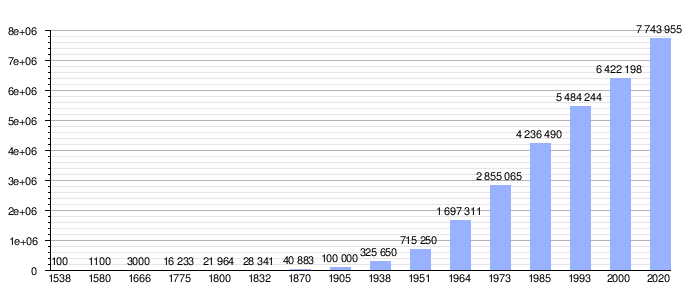 |
According to DANE figures, in 2010 Bogotá had a population of 7,363,782 inhabitants, with projections for 2017 of 8,080,734 inhabitants, which reach 9,285,331 inhabitants in its metropolitan area, however, the census carried out in 2018 showed a population for Bogotá of 7,412,566 inhabitants. It has an approximate population density of 16,470 inhabitants per square kilometer. 47.8% of the population are men and 52.2% women. The city has the lowest illiteracy rate in the country with 3.4% in the population over 5 years of age. It is the largest agglomeration of people in the country, surpassing the second nationally by more than 21%: the entire department of Antioquia including its capital (6,065,846 inhabitants).
Public services have high coverage, 99.4% of homes have electricity service, while 98.6% have aqueduct service and 87.8% have telephone communication. In the year In 2013, 10.3% of the population was in a situation of poverty, being the lowest rate in all the administrative divisions of the country, compared to a national average of 30.6%.
In Bogotá, as in the rest of the country, the accelerated urbanization process is not exclusively due to industrialization, since there are complex political and social reasons such as poverty and violence, which have motivated migration from the countryside to the city throughout the XX century, determining an exponential growth of the population in urban areas and the establishment of misery belts in their surroundings.
An example of the above is the number of displaced persons who have arrived in Bogotá. According to the Consultancy for Human Rights, Codhes, in the period 1999-2005, more than 260,000 displaced persons arrived in Bogotá, approximately 3.8% of the total population of Bogotá. The localities where the majority of the population is concentrated displaced are: Ciudad Bolívar, Kennedy, Bosa and Usme.
Ethnography
The most recent general census of the nation, carried out by the National Administrative Department of Statistics of Colombia (DANE), presents the following results regarding the ethnic distribution of the population registered in the city of Bogotá:
In this way, it was revealed that 42.7% of the capital's population is mestizo, 36.5% are white, 1.5% Afro-descendants, 0.5% indigenous, 0.01% Gypsies and 18.9% from another ethnic group.
Security
The last governors of the city have carried out campaigns aimed at the citizens tending to reduce their crime rates. violent deaths per 100,000 inhabitants in 1996, to 37.9 in 2005, which represents a reduction of 57.6%, taking into account that in the same period the population increased by more than 25%. Of these violent deaths, it was recorded that 62.8% were caused by homicides, while 20.5% were caused by traffic accidents; It is also revealed that 85.1% of the victims were men and 14.9% women. In 2014, the homicide rate in Bogotá fell even further, falling to 16.4 homicides per 100,000 inhabitants per year. This is one of the lowest homicide rates in Colombia and the lowest homicide rate in Bogotá in the last 30 years.
However, an inverse effect has been detected in terms of thefts. The substantial reduction of this scourge in the period 1998-2004, when common theft in Bogotá decreased from 29,591 cases in 1998 to 14,028 in 2004 for a reduction of 53%, has been replaced by a significant increase in 2005-2014, registering an increase of 180% in the number of thefts according to figures from the Bogotá Police, which places the theft rate at a record of 356.9 per 100,000 inhabitants per year. The increase in thefts in Bogotá in the period 2011-2015 it has negatively affected the public, highlighting the theft of cell phones, the chartering and robberies with motorcyclists with grills, being especially harmful when the victims also receive violent attacks with white weapons or blows against their physical integrity.
The Police have responded by increasing their footing, adopting surveillance strategies such as the use of drones or cell phone applications that facilitate citizen complaints. In 2015, cell phone theft was reduced by 22%, thanks to Police operations and initiatives by the National Government and cell phone operators.
Insecurity
Bogotá has a low level of insecurity compared to the other capitals of Latin America. Localities such as Kennedy, Bosa, Ciudad Bolívar and Mártires are the sectors where high numbers of violence occur. The citizens who feel most insecure are the inhabitants of the neighborhoods in the southeast, center and in strata 1 and 2. The population indicates that the homicides are related to street robberies, the presence of gangs and drug trafficking. As of 2020, in Bogotá reported an average of 214 robberies per day, a drop of 37% compared to the same period in 2019, largely due to the quarantine decreed by the national government as a measure against COVID-19, however, these had a rebound at the end of said measure.
A report by the Bogotá metropolitan police carried out in 2013 indicates that thefts exceeded forecasts by around 24,000 cases without counting the statistics where people did not report due to fear or lack of infrastructure when filing a complaint. Street theft has decreased slightly (from 51% to 49%) The same occurs in public transport (from 19% to 17%), however, theft in commercial establishments doubled (from 8% to 16%) from 2013 to 2014. In In the automotive industry sector, an average of 4 car thefts are reported a day, even from entities such as the police, the towns of Kennedy and Usaquén being the most vulnerable, the authorities maintain that most cases are due to the carelessness of their owners.
The armed conflict in Colombia has made its capital the scene of several terrorist attacks. Since the eighties, Bogotá has been the target of drug traffickers and illegal armed groups. An act that generated panic in its inhabitants occurred on December 6, 1989 when a bus bomb exploded in front of the building of the central de Colombian intelligence DAS, a fact that left 67 dead and more than 600 injured, attributed to the leader of the extinct Medellín cartel, Pablo Escobar.
On February 7, 2003, the explosion of a car bomb in a parking lot of Club El Nogal in the north zone left 36 dead and more than 200 injured. The attack was recognized by the Farc guerrilla. That same year, a car bomb exploded in front of a shopping center, leaving 6 people dead and 12 injured.
On August 12, 2010, a car bomb was detonated in front of a complex of buildings where Caracol Radio works, among other companies. The action left nine people injured.
On May 15, 2012, a sticky bomb exploded on Calle 74 and Avenida Caracas, near the financial center.
The attack directed at the former Minister of the Interior, Fernando Londoño, who was wounded. Two people died.
In 2017, on February 19, an explosion in the La Macarena neighborhood left a police officer dead and 26 injured, including 24 uniformed officers from the Mobile Anti-Disturb Squad. The ELN guerrillas assumed responsibility for the attack.
On January 17, 2019, a car bomb exploded at the General Santander Police Cadet School located to the south of the city, leaving at least 21 people dead and 68 injured.
Economy
Bogotá is the main economic center of Colombia; Most of the capitals coming from the other cities converge there, as it is the focus of the country's commerce due to its large population. It is the Colombian city with the largest number of foreign companies, one of the factors that position it as the largest labor market in its country. Bogotá is the largest business platform in Colombia, with 21% of companies registered in the country, and additionally, the city is home to 67% of high-impact Colombian ventures,
Bogotá is one of the five most attractive Latin American capitals to invest in. In Latin America, it ranks twenty-first in relation to GDP per capita. According to The Economist, Bogotá stands out for its strength associated with the size of its production and GDP per capita (the highest among the main cities in the nation), the facilities for creating companies and doing business, financial maturity, the attraction of global companies and the quality of its human capital. It is also the sixth city in Latin America to organize events, having the airport with the largest cargo volume in Latin America and the second in people.
It receives investors from all over Colombia and from other parts of the world. In 2008, the city was ranked as the fourth most influential financial center in Latin America. In the period 2003-2006, Bogotá's commercial GDP (gross domestic product) grew by 10.3% per year, representing 25.3% of the National commercial GDP, it includes the assets from the investment of other cities in the country in the city and that of many multinational companies; being higher than the GDP of Uruguay, Costa Rica, El Salvador, Panama, or Bolivia In addition, the unemployment rate is 9.8% and underemployment is 29.7%, the second lowest in the country. Bogotá has been among the top 10 most expensive cities in Latin America for several years, according to 2007 research carried out in 143 cities around the world by Mercer Human Resource Consulting, however, the cost of living is lower than the average for the 40 main cities of Latin America. In addition to this, Bogotá is projected in the medium term as a business center with international projection.
Bogotá ranked sixth among 50 Latin American cities for its quality of life standards, high potential for doing business, and excellent conditions for professional development, according to the ranking established by América Economía Intelligence. At the national level, The import of capital goods has been encouraged by the Government, especially benefiting Bogotá, which participates with 24.4% of the total national industry (2003). This is partly due to its geographical location, which makes from the city a strategic point in logistical terms, since the transport of merchandise to other parts of the country is relatively fast. In the same way, the supply of raw materials for the industrial sector in the city is facilitated, due to its proximity to agricultural regions such as the Eastern Plains. For all this, several multinational companies have established their regional operation there during the last decades. However, the distance from the ports decreases the competitive advantages to export industrial products. Thus, services (including telecommunications and commerce) are gaining share over industry.
In 2005, consumer goods led industrial production, followed by intermediate and capital goods. Of the 248,000 companies that Bogotá has, 78% are linked to service activities, contributing 76 % of employment and 79% of GDP. The towns in which the largest number of industrial establishments are concentrated are Puente Aranda, Fontibón, Kennedy, Los Mártires, Engativá and Barrios Unidos (in that order), where the industrial sectors of food, chemicals, pharmaceuticals, textiles, publishing and metalworking. Also in 2005, the town with the highest labor productivity was Tunjuelito, followed by Chapinero and Teusaquillo. Bogotá is the main tourist destination in the country, which is of particular importance taking into account the positive growth of this sector at the national level in recent years. Another industrial sector that has grown is construction, directly contributing to reactivating the economic activity of the capital.
Bogotá's main international trade partner in 2003 was the United States, followed by the European Union. The city mainly exports agricultural products (30%), chemicals (10%), and textiles (7%), and imports material transport (17%), machinery except electrical (17%), and electrical machinery (14%). In addition, Bogotá has various commercial areas and a growing number of shopping centers spread throughout its territory. Small ones are numerous in commercial areas such as Suba and Fontibón.
Popular economy
The popular economy sector continues to be an important sector of the local economy. According to the Institute for the Social Economy (IPES), the city still has 19 district market places that are located in popular neighborhoods and counterbalance the arrival of large stores, thus managing to regulate the price scheme for food, contributing to the security and food sovereignty of a metropolis of approximately 7.5 million inhabitants.
Street vendors, although controversial due to their occupation of public space, belong to the popular economy sector and continue to be one of the main axes of job creation and economic dynamics in the city. Given these realities, the efforts of the district administration have focused since 2004 on the regulated economic use of public space.
Transportation
In Bogotá, more than 13 million trips are made per day. Most of these trips are carried out by collective (traditional) public transport. The other public transport system is the TransMilenio metropolitan mass transport system. Despite being one of the most populated cities in Latin America, Bogotá does not have a Metro system. In private transportation, cars and motorcycles play a very important role. The bike path system (532 kilometers of dedicated lanes for the exclusive use of bicycles) is one of the most extensive in the Americas. For its part, taxis make about 1.1 million trips a day (see Transportation in Bogotá).
The main land access routes to the city are the North Highway and the North-Quito-South Highway, which together with the Calle 13 trunk road, form part of the Pan-American Highway in the Simón Bolívar section that connects it with Caracas, Maracaibo, Quito and Guayaquil. In the West, there is Calle 80, which after the Bridge over the Bogotá River, becomes the Medellín-Bogotá Highway. Also in the north, Carrera Séptima, which after Calle 170 is called Carretera Central del Norte and serves as an alternate route for the Autopista Norte. In the southeast, the Avenida Boyacá that connects with the Avenida Caracas and the Autopista al Llano, connect communicating with the city with the Eastern Plains. On the other hand, the Circunvalar avenue in the eastern hills, joins to the south with the road to Choachí and to the north with the one that leads to La Calera.
It is expected that in the coming years the construction of Avenida Longitudinal de Occidente will begin, a peripheral road in the west that seeks to decongest traffic within the city. Bogotá has the worst mobility in America and the fourth worst in the world according to the TomTom traffic index. Among the causes of slow mobility (between 17 and 25kph average) is the fact that the city is the most densely populated in Latin America, with 18,000 inhabitants per square kilometer. In the same way, 33% of the jobs are in 10% of the urban space.
TransMilenio
In 1998 construction began on the so-called Third Millennium Mass Transportation System "TransMilenio" and in 2000 it came into operation. Composed of articulated vehicles, which also has "feeder" services to peripheral neighborhoods and metropolitan municipalities. The system has 135 stations throughout 11 zones, and an estimated 1,700,000 people use it daily, making it one of the largest rapid transit bus systems in the world. This network has a bicycle parking service, which has no additional cost.
TransMyCable
Subway
For more than 60 years, the construction project of the first line of the Bogotá Metro has been in debate and postponement. In 2020, the design, construction and operation activities of the first subway line officially began, which was awarded to the Chinese company China Harbor Engineering Company Ltd. (CHEC) at the end of 2019. It is expected that this first line is a reality in March 2028.
According to the current design, it will be an elevated line with a high impact on the urban development of the city.
RegioTram
RegioTram will be of the Tren-Tram type to provide Bogotá and its surroundings with a fast, ecological, safe and integrated means of transport in the urban area that provides the user with a transport alternative to the existing traditional public transport systems in in the form of a regional light rail, which was awarded in 2019 to the China Civil Engineering Construction Corporation (CCECC) company and will start operating between 2023 and 2024.
In the interurban sections it acts as a suburban train with speeds of up to 100 kilometers per hour and also circulates in the urban area in tram format, which allows integration into the city fabric and shortens the duration of the trip, by avoiding modal exchanges.
Integrated Public Transport System
Bogotá has more than 498 routes of the Bogotá Integrated Transport System (SITP). The buses or minibuses circulate through the Road Network according to a set of routes established as of 2012. Passengers board the bus at bus stops or certain seasons.
Active modes
As an element of recreation, the city implemented the recreational bike lane, since the late 1970s on Sundays. At the end of the 1990s, a network of bike paths (the most extensive in Latin America) was implemented. Bogotá is a world icon for promoting the use of bicycles as an alternative mode of transportation. The network of 532 kilometers of bike paths, the Day Without a Car, the Sunday Ciclovía, the Night Ciclovía that takes place in December, the significant number of groups that promote cycling and approximately 450,000 trips made in the city corroborate why Bogotá is an example for the world of sustainable mobility. That is why Bogotá is visited by hundreds of people who come every year to learn about the infrastructure that exists for cyclists, to participate in events or to have a cycling experience. This has allowed Bogotá to be classified as one of the friendliest cities for cyclists.
Others
The pico y placa has generated controversy and worldwide recognition for the city for its policies in favor of public space and pedestrians.
On weekends and holidays, the railway line is used for the Sabana de Bogotá Tourist Train. In addition, the Tren de la Sabana from Monday to Friday transports students from universities located in municipalities surrounding the City of Bogotá, among which are the Universidad de la Sabana, the Universidad El Bosque, with its headquarters in Chía, and the Universidad Military New Granada.
On Sundays and public holidays, some of the main roads in the city are closed to make way for bicycle paths, places for sports and recreation where only pedestrians and bicycles can circulate.
Intercity transport
Central Terminal
Currently, Bogotá has a central passenger and cargo terminal located in Ciudad Salitre Occidental, however studies carried out contemplate the location of four terminals at the exits of the city (south, north, east and west), thus creating a system of intercity bus terminals.
South Terminal
It is the first satellite terminal that is currently in service, it is located in the town of Bosa on a 22,000 m² property and works in a first stage in a complementary way as a transit terminal. In 2011, adjustments were made to operations and acquisition of properties to operate as an origin-destination terminal.
North Terminal
It is a satellite terminal, a few meters from the Terminal station of the TransMilenio System on Paseo de los Libertadores Avenue with 193 street (El Cangrejal sector), in the town of Usaquén, it provides its services to the populations of La Sabana from Bogotá (which currently stop at said portal) and east from Cundinamarca (accessed via La Calera and Choachí), as well as Boyacá and Santander. This terminal began operations in 2018.
Air transportation
El Dorado International Airport in Bogotá, is the most important in the country, it is the 1st in cargo in Latin America and 2nd in passengers. With a national and an international dock, as well as a cargo terminal made up of two docks. This airport handles several national and international destinations. In 1981 an annex terminal called Puente Aéreo was inaugurated, managed by the airline Avianca, and in 1998 a second runway was inaugurated. Attached to El Dorado is the CATAM Military Base, reserved for military and government flights. This complex (International Airport, Air Bridge and CATAM) makes up the airport with the highest cargo volume and the second in terms of passengers in Latin America, only behind the São Paulo-Guarulhos International Airport.
In 2006, the tender for the twenty-year concession of the El Dorado air complex was delivered, which seeks to increase its capacity to 16 million passengers, double the current one. The project contemplates the demolition of the current building and the construction of a new one. It is estimated that when the terminal is built, the flow of passengers will increase from 8 to 16 million. El Dorado will have a second terminal that will be ready in 2017, and it will be located in the surroundings of Facatativá and will have an area of 1,300 hectares. [citation required]
Additionally, in the rural area of Suba, there is the Guaymaral Airport, which allows the landing of small aircraft and manages the aerial operation of the metropolitan police.
Health
Bogotá has a network of institutions that provide health services attached to the District Health Secretariat; These institutions are grouped into three levels according to the care they provide: the first level has 10 hospitals that offer basic care, general medicine, laboratory tests, emergencies, hospitalization, and dentistry; The second level has 7 hospitals, which, apart from the services of the first, also offer care in basic specialties, optometry and psychology; The third level brings together 5 hospitals, which additionally provide subspecialty services such as cardiology, neurology, genetics, dermatology, etc.
Additionally, the Capital District has 142 medical care points distributed in all localities, where you can access services of varying complexity. The attention in each institution is governed by the guidelines of Law 100 of 1993 and its regulatory decrees, which establish the subsidized regime for users. Currently there are 22 health provider entities (EPS), which have a coverage of 4,963,607 users according to the statistics presented by the Ministry of Social Protection corresponding to November 30, 2005. The capital has recently been becoming a destination for nationals and foreigners, who seek medical treatment, due to the presence of internationally recognized medical institutions, such as the Barraquer Clinic (specialized in Optometry and Ophthalmology) and the Abood-Shaio Foundation, as well as cancer treatment centers, treatment of neurological diseases and plastic and reconstructive surgery, in addition to the existence of several blood, tissue and stem cell banks.
Education
The city has an educational system that covers primary, secondary and university levels. Due to the constant migration of people to the capital of the country, the availability of places to access the education offered by the State is often insufficient. The city also has a varied system of private colleges and schools, including bilingual, military, technical, country, religious communities, as well as different school calendars and study hours.
According to the National Higher Education Information System of the Ministry of Education, the city has a total of 104 higher education institutions, both public and private. Bogotá has the largest university offer of the country; it has 450,000 higher education students and 70,000 higher education graduates.
The city is home to the sixth university inaugurated in the American continent: the Santo Tomás University, founded on June 13, 1580 by the Papal Order in Rome and called the "First University Cloister of Colombia&# 3. 4;.
In addition, Bogotá has 9 of the best universities in the country according to the Ministry of National Education, all with high-quality accreditation from the National Accreditation Council (CNA), these are: The National University of Colombia, the de los Andes, the Pontificia Universidad Javeriana, the National Pedagogical University, the University of La Salle, the University of Rosario, the Jorge Tadeo Lozano University, the El Bosque University, the Externado de Colombia University and the Santo Tomás University.
Other universities such as the EAN University, the Free University, the La Gran Colombia University, the Nueva Granada Military University, the Catholic University of Colombia, the Colombian School of Engineering, the University of Applied and Environmental Sciences, the University of San Buenaventura, the Autonomous University of Colombia, the Antonio Nariño University, the Central University, the Sergio Arboleda University, the Pilot University of Colombia, the ECCI University, the Minuto de Dios University Corporation (UNIMINUTO), the Area University Foundation Andina, the National Unified Corporation of Higher Education (CUN), the Cooperative University of Colombia, and the Colegio Mayor de Cundinamarca University.
The city has the Francisco José de Caldas District University, which is the official higher education institution of the Capital District. It also has the Ciudad Universitaria of the National University of Colombia, which is the largest university campus in the country and is located in the traditional sector of Teusaquillo. Various private universities are concentrated in the town of La Candelaria.
In the city are the military training institutions for future officers of the Colombian National Army (General José María Córdova Military Cadet School) and the Colombian National Police (General Santander Police Cadet School), as well as as the institution that provides training to the senior officers of all the Colombian Military Forces (Superior School of War).
Culture
Bogotá has been called «The South American Athens», a nickname that was strengthened at the end of the XIX century and beginning of the XX, at the initiative of the Spanish writer Marcelino Menéndez Pelayo, due to his great admiration for Colombian philosophers, including Rufino José Cuervo and Miguel Antonio Caro. The city has a wide cultural offer that has increased considerably in recent decades, as well as being the venue for important festivals with extensive experience and national and international recognition.
In it reside people from all over the country, who have been contributing to the ancient cultural traditions typical of the city. It is noteworthy that Unesco awarded the city the title of World Book Capital in 2007. It was also declared the Ibero-American capital of culture that same year. In May 2012 Unesco designated it as "Creative City of Music", as part of the organization's Creative Cities Network.
The Corferias Fair and Exhibition Center is the venue for cultural events. The Bogotá International Book Fair, Expoartesanías, and ArtBo (Bogotá International Art Fair) take place here. In addition, in 2008 Corferias was an important center in the Ibero-American Theater Festival and headquarters of the Campus Party. The venue also hosts events of a different nature such as the Bogotá International Fair (industry and commerce) that takes place during even years, and in 2009 it also hosted the MTV Awards for Latin America.
The Festivals in the Park are a set of nine events held throughout each year. Among these, the most renowned are: the Rock in the Park Festival (receives more than 500,000 attendees in the three days of celebration, one one of the largest free rock events in the world.), the Jazz Festival in the Park, the Salsa Festival in the Park, and Hip Hop in the Park held in the Simón Bolívar Metropolitan Park. This park also hosts the inauguration and the most important activities of the Summer Festival that is held in various parts of the capital during the month of August.
Other notable events are the Chicha, Vida y La Dicha Festival (declared an event of cultural interest in Bogotá), the Bogotá Carnival, which celebrates the city's birthday, and the European Film Festival, annual film show. However, one of the most important cultural events in the capital is the Ibero-American Theater Festival, which takes place every two years and is classified as one of the most prestigious in Latin America.
Architecture and infrastructure
In the city there is a very varied infrastructure that goes from the so-called informal settlements, through colonial architecture and even contemporary constructions. The urban morphology and the typology of the viceregal constructions of Bogotá were maintained until, even, the end of the XIX century, much later of the Independence of Colombia (1810).
The urban layout corresponded to the checkerboard plan implemented by the Laws of the Indies since the middle of the xvi century. This persistence of the colonial configuration is currently visible in part of La Candelaria, the Historic Center of Bogotá.
Also until the end of the XIX century, colonial houses with a maximum of two floors, with a central patio, a two waters, clay tile and cantilevered balconies. In some cases, these balconies were closed with glass during the Republican period, a characteristic that particularly distinguishes the architecture of the sector (for example, the Casa de Rafael Pombo, etc.).
Republican architecture was the style that prevailed between 1830 and 1930. Although there were attempts to consolidate a modern language, only until the construction of the University City or White City for the National University of Colombia (1936- 1939), this purpose was achieved. The layout of this work was developed by the German architect Leopoldo Rother, although other rationalist architects participated in the design of the campus buildings.
In addition to this aspect, works in the art deco style, expressionism and organic architecture were also developed. This last trend was embraced by Bogota architects of the second half of the XX century, such as Rogelio Salmona.
In 2006 Bogotá received The Golden Lion Award at the Tenth International Architecture Exhibition of La Biennale de Venezia, in recognition of «its efforts towards social inclusion, education, housing and public space especially through innovations in transport".
Buildings
Bogotá is home to the tallest buildings in the country. The BD Bacatá is a set of two towers of 67 and 56 floors, 216 m and 167 m high, it is located in Carrera Quinta with Calle Diecinueve. Since April 2015, the tallest of the towers is the tallest building in Colombia. The Torres Atrio complex is currently being built in the city, two skyscrapers of 268 and 200 meters respectively, which hope to see the light of day at the end of 2020 and 2022. The Colpatria Tower was the tallest building in Colombia since the year it was completed in 1979. It has had a distinctive night lighting system since 1998 and has become an icon for the city. In 2001, it was named as an Asset of Cultural Interest by the district Mayor's Office. The International Trade Center is a skyscraper located in the International Center of Bogotá. With its fifty floors, it was the highest in Colombia and Latin America for two years. In the city, the construction of a skyscraper called Forza Tower is also planned, which with 457 meters could become the highest in Latin America and Colombia.
Literary activity, libraries and archives
Unesco proclaimed Bogotá as World Book Capital 2007, in recognition of the city's literary activity. Programs such as Libro al Viento, the library network, and the presence of organizations that work jointly to promote books and reading in the city were highlighted. Also several specific initiatives for the World Book Capital program and the commitment of groups, both public and private, involved in the book sector.
The National Library of Colombia, under the Ministry of Culture, and the Luis Ángel Arango Library, under the Bank of the Republic, are the two largest public libraries in the city. The first has more than two million copies, with an important collection of old books. The second has almost two million copies. With 45,000 square meters and 10,000 daily visitors, it is one of the most dynamic cultural centers on the continent. The Alfonso Palacio Rudas Library, north of the city, also depends on the Banco de la República, with nearly 50,000 copies. Other large public libraries are: the Library of Congress of Colombia (with 100,000 copies), the Caro y Cuervo Institute (with almost 200,000 copies, the most important Latin American library in Philology and Linguistics), the Library of the Academy of History, the Library of the Academy of Language, the Library of the Colombian Institute of Anthropology and History ICANH and numerous university libraries.
The city also has the Biblored, an institution that manages 16 small libraries and 4 large public libraries (Virgilio Barco Library, El Tintal Library, El Tunal Library and Julio Mario Santodomingo Library). It also has the six headquarters of the Colsubsidio Family Compensation Fund Library Network and, with libraries and documentation centers attached to institutions such as the National Museum of Colombia (specializing in old books, catalogs and art), the Museum of Modern Art of Bogotá, the French Alliance, the Colombo American Center, etc. Another set of libraries in Bogotá is made up of the new collaborative initiatives between the State, the city and international organizations. This is the case of the Gabriel García Márquez Cultural Center, designed by order of the Fondo de Cultura Económica de México, and the Spanish Cultural Center, which will begin to be built with public funds from Bogota and the Spanish Government in Carrera Tercera with Avenida 19, in the Bogota center.
In addition to the libraries, Bogotá has a set of historical archives among which the General Archive of the Nation stands out, which houses nearly 60 million documents, being one of the largest depositories of primary historical sources in Latin America. Near its headquarters is the Archive of Bogotá, inaugurated in 2003. Additionally, there are archives of restricted consultation due to their specific importance: the Musical Archive of the Primate Cathedral of Bogotá (with thousands of choir books and songbooks from the viceroyalty period), the Archdiocesan Archive, the Archive of the Bogotá Council Seminary, the Historical Archive of the National University of Colombia and the Archive of the Bogotá Mint, dependent on the Bank of the Republic.
Museums and Galleries
The city offers 90 museums and nearly 70 art galleries, among which the National Museum of Colombia stands out, whose collection is divided into four collections: art, history, archeology and ethnography; and the Gold Museum, with 35,000 pieces of gold and tumbaga, as well as 30,000 ceramic, lithic and textile objects, represents the largest collection of pre-Hispanic gold and silver work in the world.
The Botero Museum also stands out, where you can find, in addition to 123 works by Fernando Botero, 87 works by international artists; the Museum of Modern Art in Bogotá, which has a collection of graphic arts, industrial design and photography; the Museum of Colonial Art that brings together the most important collection of viceregal art in Colombia; and the Gilberto Alzate Avendaño Foundation, which, in addition to carrying out activities related to the performing arts, temporarily presents art exhibitions in its halls.
Among the scientific museums are the Archaeological Museum - Casa del Marqués de San Jorge, which has nearly 30,000 pieces of pre-Hispanic art; the Institute of Natural Sciences (UN) (which governs the Natural History Museum of the National University of Colombia, one of the four largest natural science museums in Latin America); and the Ingeominas Geological Museum has a collection specialized in Geology and Paleontology.
Bogotá also has historical museums such as the Jorge Eliécer Gaitán House Museum, the Independence Museum, the Quinta de Bolívar and the Francisco José de Caldas House Museum, as well as the Maloka headquarters and the Children's Museum of Bogotá that attract a considerable number of visitors, especially among children. These centers will be joined by several new museums such as the Art Deco Museum and the Bogota Museum.
- Museums and galleries of Bogotá
Parks
Bogotá has an extensive system of parks that are integrated with each other by a set of pedestrian corridors and bicycle paths. These are combined with small squares, plazas, wetlands and boulevards. The city government has counted more than a thousand urban parks. Bogotá has a set of green areas, urban parks, protected areas and special management areas.
The Simón Bolívar Metropolitan Park is the most important in the city since it is the largest with nearly 400 hectares constituting the "lung of the city". Sports-type venues are included such as the Palacio de los Deportes, recreational such as the Children's Museum, educational such as the Virgilio Barco Library, environmental such as the José Celestino Mutis Botanical Garden and tourist such as the Plaza de los Artesanos with its craft fairs.
Performing Arts
The city has forty-five theaters. The main ones are the Teatro Colón and the halls of the National Theater in its two venues, the one on La Castellana and the one on Calle 71, as well as the traditional hall of the TPB, the Teatro La Candelaria, the Teatro Camarín del Carmen (with more than 400 years of existence; which was before a convent, then a hospital, then a hotel and currently a restaurant and theater), the Colsubsidio Theater (private), and a symbol of the city, the remodeled Jorge Eliécer Gaitán Theater, the one with the largest capacity in South America today, located in Carrera Séptima in the International Center, the León de Greiff Auditorium located at the National University of Colombia, is the largest auditorium and with the best acoustics in Colombia, where the Bogotá Philharmonic Orchestra currently performs and many other cultural events. There is also the so-called open-air theater, the Media Torta, where musical events are also held.
Regarding the seventh art, the metropolis has its own film festival, the Bogotá Film Festival, and numerous theaters, which present both the best commercial films of the moment, and art cinema, which allows us to appreciate the various achievements of European, Asian and Latin American directors.
The main cultural pole of the city is located in the sector of La Candelaria, Historic Center of the city; This presents a unique concentration of universities and academic centers in South America. In this same sector are the vast majority of the important museums of the city; For these and more reasons, in 2007 Bogotá was designated as the Ibero-American Capital of Culture.
Media
Open television
The city is home to two regional public channels, Canal Trece and Canal Capital, and a local private commercial channel called Citytv that can be seen on DTT. The three national private channels Canal 1, Caracol Televisión and RCN Televisión and the two national public channels Canal Institucional and Señal Colombia are broadcast in the city.
Subscription TV
The city has multiple digital satellite television services such as DirecTV, Claro and Movistar, and digital cable television offered by Claro, the Tigo company from Millicom, the HV Televisión company, the Colcable company, the company Conexión Digital Express that offers the digital television service through the ADSL and GPON network (IPTV), and analog and digital through the two-way network (HFC), the cable television service of the companies Cablesas and Nubenet Telecomunicaciones, the television service virtual digital network offered by the GPON network (IPTV) of the ETB and small cable television systems distributed by localities.
Radio stations
In Bogotá, all the major radio stations in the country and their different stations in AM, FM, and DTT are established, in 70% of the FM stations the RDS service is available.
Newspapers
It also has several newspapers, among them: El Tiempo, El Espectador, Portafolio, El Nuevo Siglo, La República, El Espacio and the newspapers Publimetro and ADN, which have free circulation. Among the weeklies, Voz stands out.
Gastronomy
In Bogotá there are restaurants serving typical, international and specialized food scattered throughout the city. The main sectors of international restaurants are Usaquén, La Macarena, Zona G, La Candelaria and the International Center. In these places it is also easy to find restaurants specialized in the gastronomy of other regions of Colombia.
Among the typical Bogota dishes, the ajiaco santafereño can be highlighted, which is a soup prepared with chicken, potatoes of different varieties, corn on the cob and guascas (a spice), usually cream and capers are added and it is accompanied by avocado and curuba cream. Another typical dish of the capital is the small mazamorra, which is also consumed in the department of Boyacá. This is a corn soup with meat, peas, broad beans, menudo, stems, and chopped sabanera potatoes that is usually accompanied with rice, roast beef, and salty potatoes.
It is also traditional to consume tamales with Santa Fe chocolate; The Colombian tamale is a corn dough paste with meat or chicken, chickpeas, carrots, and seasonings, wrapped in banana leaves and steamed. Of course no one can leave Bogotá without tasting from the ubiquitous "tinto" (coffee), to infinite dishes all prepared with 100% Colombian coffee.
The main typical desserts of the city are figs with arequipe, strawberries with cream, dessert of creams, snacks and curd with melao. The canelazo is a drink from the Cundiboyacense Altiplano that is prepared with panela water, brandy and cinnamon, and is consumed hot.
In the outskirts of the city there are places where you can find pandeyucas, pandebonos and almojábanas, which are cornmeal rolls, eaten with curd or cheese.
The changua is a soup that includes eggs and toast in milk with salt and some spices, it is a traditional breakfast of the people of Bogotá and Cundinamarques, who accompany it with bread, chocolate, oatmeal, chicha, masato and garullas, which are its part drinks typical of the region.
Other typical dishes of the city and its region are the bread soup in a casserole, the meatball, and the Bogotá mazamorra and stew, which include sabanera potatoes.
Religion
| Religion in Bogotá (2022) |
|---|
| Catholic (48.0 %) Protestant (17.0 %) No (30.0 %) others (3.0 %) |
As in the rest of Colombia, the Political Constitution guarantees the freedom of creeds and cults. This means that during different times of the year religious celebrations are common, which have become an important part of Bogotá society and have made it a tourist destination for this type of activity.
Since its early years, the city has had a tradition of roots in Catholicism. Proof of this religious tradition is the number of temples built in the historic center of the city, and the customs associated with it, such as the ascent to the Monserrate and Guadalupe tutelary hills, on whose tops there are Catholic temples. The city is also the seat of the Archdiocese of Bogotá (which houses some Bogotá towns and municipalities of Cundinamarca to the east of the District), established as a diocese on September 11, 1562 and later elevated to an archdiocese on March 22, 1564; its church matrix is the Metropolitan Cathedral Basilica of Bogotá and Primada de Colombia, as well as other suffragan dioceses in the territory to the west of the District such as Engativá, Fontibón and Soacha. In addition, it houses the headquarters of the Episcopal Conference of Colombia and the Latin American Episcopal Council (CELAM).
Bogotá is also home to other religious movements, among which Protestantism, which has various temples in different sectors of the city, stands out as the movement that has grown the most in recent years in number of faithful and political strength, in particular, neo-Pentecostal megachurches that have sprung up in the city since the late XX century. The city also has a An important Muslim community which has two mosques as its center of congregation, the Istanbul Mosque located in the Chapinero neighborhood and the Abu Bakr Mosque, which is the largest in the city located at Carrera 30 with Calle 80; In addition, the Muslim community has an Islamic center in the center of the city. There are also five synagogues of the Jewish religion in the north of the city, a church of the Orthodox religion located in Chapinero, and four Buddhist centers also located in the north of the city.
One of the largest modern religious buildings in the city is the Bogotá Temple, the center of congregation of the Mormon movement, located on 127th Street with Autopista del Norte.
In recent years, the number of people unaffiliated with any religious movement, understood as atheists and agnostics, has begun to become visible and increase in the city. As a result, secular and non-theistic communities have been created. (e.g. the Association of Atheists and Agnostics of Bogotá).
Sports
The District Institute of Recreation and Sports promotes recreation, sports and the proper use of parks in Bogotá.
Different sports are practiced professionally and playfully in Bogotá. For example, indoor soccer has been declared a symbol sport of Bogotá, since it is the most practiced discipline in the city. Bogotá hosted the first Bolivarian Games held in 1938, from the 2004 national Games obtaining first place With more gold medals, it was the headquarters of the Colombian soccer team where they won the 2001 Copa América title and hosted the 2011 U-20 World Cup final.
Soccer has an important relevance for Bogotá. Colombian professional soccer is a national sporting event that significantly attracts the interest of fans of this sport in the city. Thus, two of the five professional clubs, Millonarios and Santa Fe, have a significant fan base. The two teams play local at the Estadio Nemesio Camacho El Campín. Other teams in the city are La Equidad, in the First Division; Tigres, Fortaleza and Bogotá F.C. in the second division; the four teams play their home games at the Estadio Metropolitano de Techo.
The twenty-four titles won in Colombian professional soccer (Millionarios 15, Santa Fe 9) make Bogotá the second Colombian city with the highest number of championships won, but also the city with the most super leagues won (4 Santa Fe, Millonarios 1). In addition to being the second city with the most Colombian Cup titles (Millionarios 2, Santa Fe 2 and La Equidad 1) and the second city in the country with the most international tournaments won: 1 Copa Sudamericana, 1 Copa Suruga Bank (won by Santa Fe), 2 Simón Bolívar Cups (won by Santa Fe and Millionaires) and 1 Merconorte Cup (Millionaires).
As for women's soccer, the three main teams in the city have their female affiliates. The city has two league titles won by Santa Fe.
| Equipment | League | Foundation | Stadium | Palmarés |
|---|---|---|---|---|
| Millionaires Football Club | First category A | 1946 | Nemesio Camacho El Campín | 21 (15 National Leagues,1 Colombia Superlight, 3 Colombia Cups) international (1 Merconorte Cup, 1 Simón Bolívar Cup) |
| Independent Santa Fe | First category A | 1941 | Nemesio Camacho El Campín | 18 (9 National Leagues,4 Superlights of Colombia, 2 Colombia Cups) international (1 South American Cup, 1 Copa Suruga Bank, 1 Copa Simón Bolívar) |
| Independent Santa Fe Female | Women's Professional League | 2016 | Nemesio Camacho El Campín | 2 (2 National League) |
| Club Deportivo La Equidad | First category A | 1982 | Metropolitan Techo | 1 (1 Colombia Cup) (3 national leagues) |
| Bogotá Football Club | First category B | 2003 | Metropolitan Techo | None |
| Fortaleza Football Club | First category B | 2010 | Metropolitan Techo | None |
| Tiger Football Club | First category B | 2016 | Metropolitan Techo | None |
| Millionaires Football Club Women | Women's Professional League | 2018 | Nemesio Camacho El Campín | None |
| Club Deportivo La Equidad Feminino | Women's Professional League | 2017 | Metropolitan Techo | None |
In basketball, Bogotá participates in the country's professional league, represented by Guerreros de Bogotá and Piratas de Bogotá, both teams play at the Coliseo El Salitre.
| Equipment | League | Foundation | Stadium | Palmarés |
|---|---|---|---|---|
| Pirates of Bogotá | National Basketball Cup | 1995 | Coliseum El Salitre. | 4 (4 Leagues) |
| Guerreros de Bogotá | National Basketball Cup | 2011 | Coliseum El Salitre. | 1 (1 League) |
In Futsal, Bogotá participates with three teams in the Colombian Futsal League: Saeta Sports Club, Lanús Colombia Sports Club and Cóndor Sports Club. The Bogota teams have yet to win titles in this league. These teams play at the Palacio de los Deportes and Parque Salitre respectively.
In Baseball, the city had the Águilas de Bogotá team of the Colombian Professional Baseball League during the 2010-2011 season.
In Rugby, Bogotá has its own league, the Bogota Rugby League in the absence of a national league for this sport in the country.
In individual sports, Bogotá participates with its athletes in competitions such as the Tour of Colombia in Cycling, organizes events in athletics such as the Bogotá Half Marathon and in tennis such as the WTA Tournament of Bogotá and the extinct ATP World Tour 250 of Bogotá.
Other important sports venues are the El Campín Indoor Coliseum, the Simón Bolívar Park aquatic complex, the Palacio de los Deportes and the El Salitre Sports Unit, which includes the Luis Carlos Galán Sarmiento Velodrome (home of the World Cycling Championships in 1995 track), the Diamante El Salitre (baseball stadium), the El Salitre Coliseum (basketball pavilion), the Mario Soto Bike Crossing Track, the El Salitre Skating Track (speed and road track), among others.
| Predecessor: - | Bolivarian Republic 1938 | Successor: |
Symbols
Flag
The flag of Bogotá is made up of a yellow horizontal stripe, which occupies the upper half, and a red horizontal stripe, which complements the lower part. It was adopted as a symbol of the city in 1952 through decree 555 of the Special District.
The flag originates from the insurgency movement against the viceregal authorities that broke out on July 20, 1810.
Shield
The coat of arms of Bogotá was granted by Carlos I of Spain for the territory of the New Kingdom of Granada according to a Royal Decree issued in Valladolid, Spain, on December 3, 1548. It was made official and adopted as a symbol of the city by Agreement 31 from 1932.
Anthem
The anthem of Bogotá was written by the poet Pedro Medina Avendaño and its music was the work of Roberto Pineda Duque. It was presented for the first time on August 7, 1974 and was made official as the city's anthem by decree 1000 of the same year.
Tree and flower logo
The walnut tree, Juglans neotropica, was declared the flagship tree of the city by district agreement number 069 of 2002.
At the initiative of the Council of Bogotá through project 088 of the year 2003, and through agreement number 109 of December 29, 2003, the orchid Odontoglossum luteopurpureum (Lindl.) was adopted as the flower insignia of Bogotá, highlighting this species present in the hills surrounding the Bogotá savannah for its protection.
Motto
The motto or brand of the city is "Bogotá: 2600 meters closer to the stars", adopted by the Council of Bogotá through agreement 446 of 2006.
Others
- The sport symbol of the city is football (futsal), according to the agreement of the Council 133 of 2004.
- The patron saint of the city is Santa Isabel de Hungary, for the consecration of the archdiocese of Bogotá since the end of the centuryXIX.
Tourism
Bogotá is known as an international tourist destination, occupying the 21st position out of 53 chosen, according to the newspaper The New York Times. It is also the main destination for foreigners visiting Colombia, with 52% of international visitors.
Important tourist places in Bogotá are the José Celestino Mutis Botanical Garden, the Gold Museum, the Jenny Garzón Bridge, the Quinta de Bolívar, the National Observatory, the Bogotá Planetarium, Maloka, the Botero Museum, the Plaza de Bolívar, the viewpoint of the Colpatria Tower as well as the La Calera Viewpoint, the Banderas a Las Américas Monument (next to the Banderas TransMilenio station) and La Candelaria, a town that is a heritage site and an Asset of Cultural Interest of National Character. In addition, the city has different mechanical amusement parks such as: Salitre Mágico and Mundo Aventura.
In Bogota there is a variety of accommodation on offer that ranges from backpacker inns to five-star hotels. The hotel offer in the historic center of La Candelaria and its surrounding areas is aimed at a public that loves culture and the arts. The hotels located near Ciudad Salitre are aimed at visitors who make short stopovers in Bogotá or need proximity to El Dorado International Airport. On the other hand, the hotels located to the north of the city are focused on business, shopping or pleasure tourism.
The city has the Tourist Train of the Sabana de Bogotá that runs on weekends and holidays from the center of Bogotá to the Jaime Duque Park in Tocancipá, Zipaquirá and on occasions, to Nemocón.
Twinned cities
Bogotá signed a city twinning agreement with Miami (United States) in 1971, another with Cádiz (Spain) in 2008 and another with Chicago in 2009. In 1982 the city signed a twinning agreement for cooperation International with Seoul (South Korea). On the other hand, Bogotá is part of the Union of Ibero-American Capital Cities (UCCI) that groups 27 cities in Ibero-America.
Contenido relacionado
Assault Guard
1800
1945



